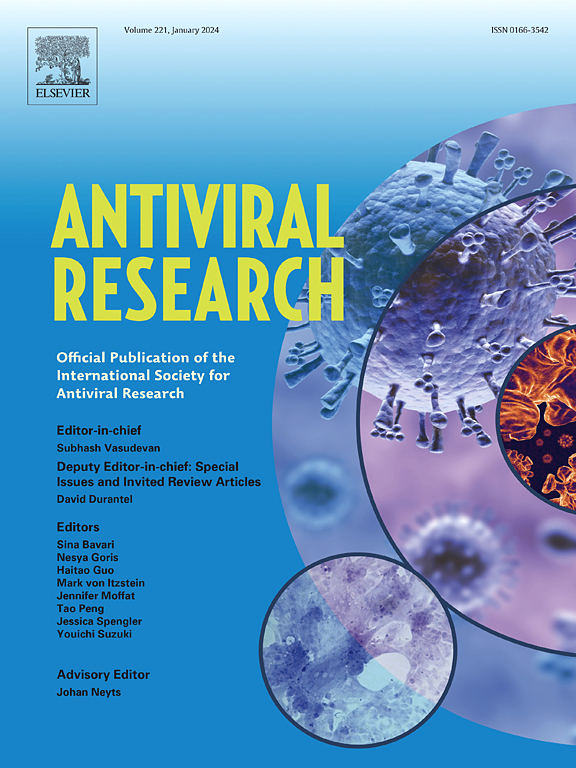Optimization of Bangladesh and Malaysian genotype recombinant reporter Nipah viruses for in vitro antiviral screening and in vivo disease modeling
IF 4.5
2区 医学
Q1 PHARMACOLOGY & PHARMACY
引用次数: 0
Abstract
Nipah virus (NiV) causes near-annual outbreaks of fatal encephalitis and respiratory disease in South Asia with a high mortality rate (∼70%). Since there are no approved therapeutics for NiV disease in humans, the WHO has designated NiV and henipaviral diseases priority pathogens for research and development. We generated a new recombinant green fluorescent reporter NiV of the circulating Bangladesh genotype (rNiV-B-ZsG) and optimized it alongside our previously generated Malaysian genotype reporter counterpart (rNiV-M-ZsG) for antiviral screening in primary-like human respiratory cell types. Validating our platform for rNiV-B-ZsG with a synthetic compound library directed against viral RNA-dependent RNA polymerases, we identified a hit compound and confirmed its sub-micromolar activity against wild-type NiV, green fluorescent reporter, and the newly constructed bioluminescent red fluorescent double reporter (rNiV-B-BREP) NiV. We furthermore demonstrated that rNiV-B-ZsG and rNiV-B-BREP viruses showed pathogenicity comparable to wild-type NiV-B in the Syrian golden hamster model of disease, supporting additional use of these tools for both pathogenesis and advanced pre-clinical studies in vivo.
优化孟加拉国和马来西亚基因型重组报告尼帕病毒,用于体外抗病毒筛选和体内疾病建模。
尼帕病毒(NiV)几乎每年都会在南亚爆发致命的脑炎和呼吸道疾病,死亡率高达 70%。由于目前尚无针对人类 NiV 疾病的获批疗法,世界卫生组织已将 NiV 和鸡病毒疾病指定为优先研发的病原体。我们生成了一种新的孟加拉循环基因型重组绿色荧光报告基因 NiV(rNiV-B-ZsG),并将其与之前生成的马来西亚基因型报告基因(rNiV-M-ZsG)一起进行了优化,以便在原代类人呼吸细胞类型中进行抗病毒筛选。通过使用针对病毒 RNA 依赖性 RNA 聚合酶的合成化合物库验证 rNiV-B-ZsG 平台,我们发现了一种命中化合物,并证实了它对野生型 NiV、绿色荧光报告物和新构建的生物发光红色双报告物(rNiV-B-BREP)NiV 的亚微摩尔活性。我们还进一步证明,在叙利亚金仓鼠疾病模型中,rNiV-B-ZsG 和 rNiV-B-BREP 病毒的致病性与野生型 NiV-B 不相上下,这支持将这些工具进一步用于体内致病机理和先进的临床前研究。
本文章由计算机程序翻译,如有差异,请以英文原文为准。
求助全文
约1分钟内获得全文
求助全文
来源期刊

Antiviral research
医学-病毒学
CiteScore
17.10
自引率
3.90%
发文量
157
审稿时长
34 days
期刊介绍:
Antiviral Research is a journal that focuses on various aspects of controlling viral infections in both humans and animals. It is a platform for publishing research reports, short communications, review articles, and commentaries. The journal covers a wide range of topics including antiviral drugs, antibodies, and host-response modifiers. These topics encompass their synthesis, in vitro and in vivo testing, as well as mechanisms of action. Additionally, the journal also publishes studies on the development of new or improved vaccines against viral infections in humans. It delves into assessing the safety of drugs and vaccines, tracking the evolution of drug or vaccine-resistant viruses, and developing effective countermeasures. Another area of interest includes the identification and validation of new drug targets. The journal further explores laboratory animal models of viral diseases, investigates the pathogenesis of viral diseases, and examines the mechanisms by which viruses avoid host immune responses.
 求助内容:
求助内容: 应助结果提醒方式:
应助结果提醒方式:


